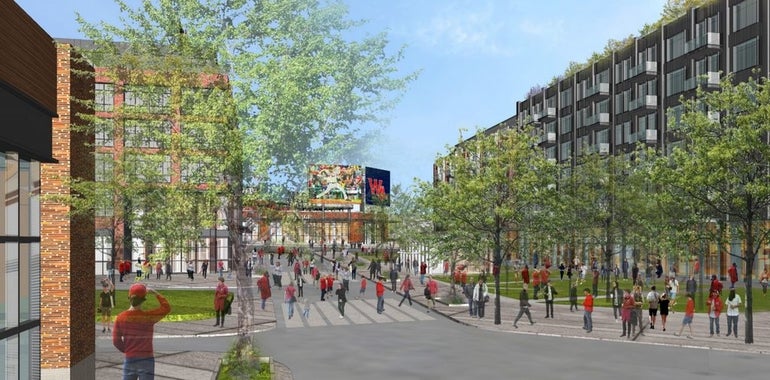A New England mill city was looking to attract a baseball team and help cement the city’s reputation as a growing economy. So the city made a deal to build a new stadium at an old industrial site near downtown.
If the story from Manchester, N.H., sounds familiar to those in or around Worcester, it’s because plenty of cities nationally these days see an economic development opportunity in minor league stadiums.
If they can redevelop a blighted site as a ballpark, these city officials feel they could help turnaround a neighborhood with new housing or other ancillary growth. And if they can bring in thousands of fans for a game, they hope, those fans will eat at nearby restaurants before or after the game or spend their money elsewhere in the city while there.
In Manchester, city officials signed a deal in 2003 to move a baseball team from New Haven, Conn., offering $25 million to build a new stadium.
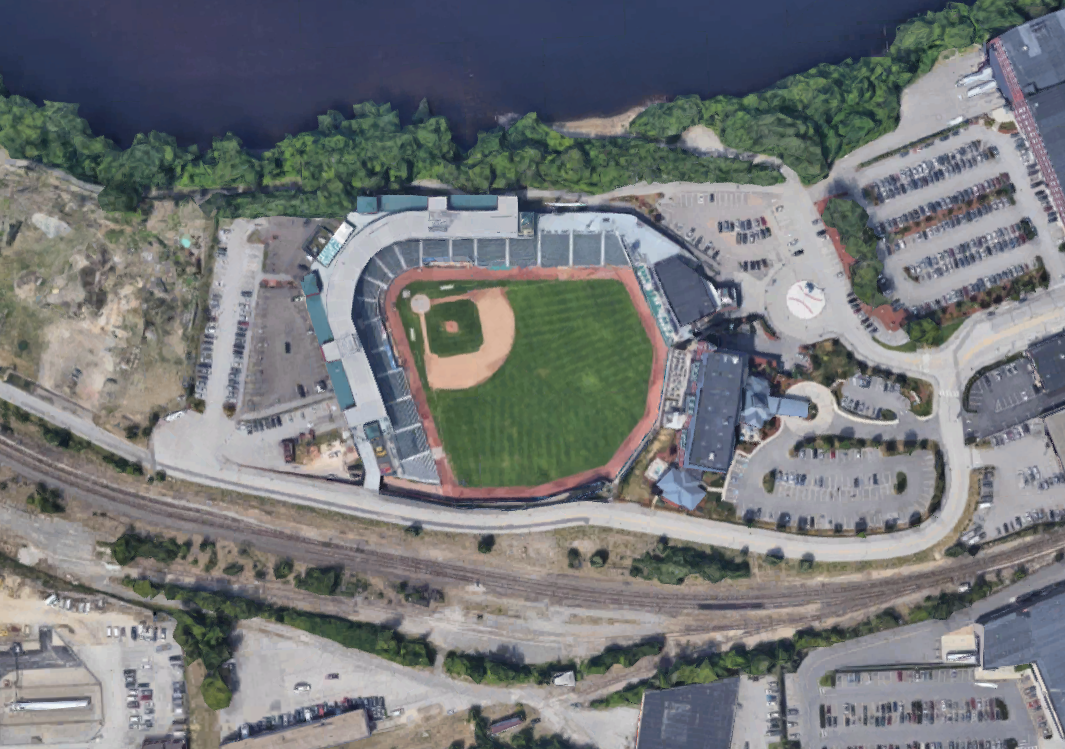
Like Worcester, Manchester had only a few years prior fielded a new hockey team and was looking to sports to help the city make a name for itself. Like in Worcester, city leaders saw a chance to spur new development just south of downtown to help the city recoup costs through additional tax revenue.
Manchester’s Northeast Delta Dental Stadium, which opened in 2005 on the edge of the Merrimack River, has brought some new development, including a six-story Hilton Garden Inn just beyond the outfield wall. One new housing development opened just down the road along the river a few years after the park opened, and a second small cluster of buildings opened at a long vacant lot next to the stadium in 2016.
But other than the hotel, not much of the new development can be directly tied to the ballpark, said Doug Blais, a business professor at Southern New Hampshire University in Manchester, reflecting a common refrain among sports economists. SNHU itself opened a new location in a renovated mill building a short walk away.
“The hotel had a fairly direct [connection] because it was part of that initial development, but I think after that – what SNHU has done – there’s really no connection” to the ballpark, Blais said.
Economic development with sports
The Worcester Business Journal has analyzed a dozen stadium construction and financing agreements from the upper levels of minor league baseball to see how other cities – like Worcester with the Pawtucket Red Sox – have bet on minor league sports as linchpins for more jobs and tax revenue growth.
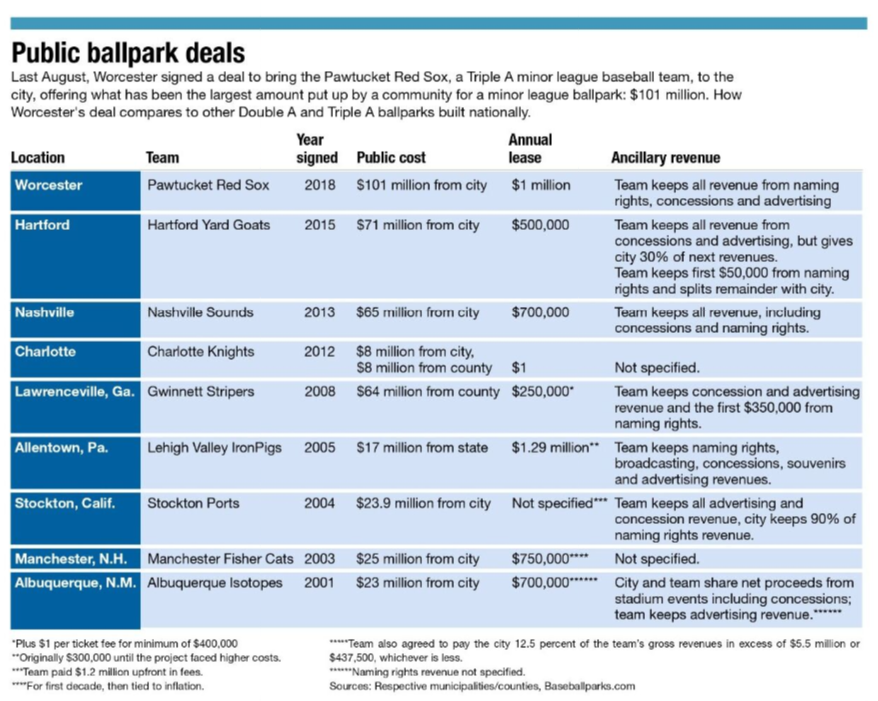
Like with tax-increment financing agreements analyzed by the WBJ for the rest of the Tax Breaks: Paying for Growth series, communities are confident they can choose the right projects to spur economic growth. In the process, they’re building and owning something – stadiums for private entities they lease to – they’d otherwise rarely get into.
In the process of building stadiums, they give up tax revenue on the sites by owning the properties themselves.
Gauging the impact of stadium developments is notoriously tough because how much new construction or visitor spending is attributable to a new stadium can be nearly impossible to pin down. But sports economists have been nearly unanimous in calling public financing for stadiums foolish economically.
“I would argue in favor of it as a small piece of a much larger pie,” Blais said, comparing Manchester’s decision a decade and a half ago to Worcester’s. “It’s much easier to say it’s been successful at a $25-million price point rather than a $100-million price point.”
In minor league baseball, few cities these days are able to attract new teams without financing most or all of costs related to new stadiums.
Gwinnett County, just outside Atlanta, paid $64 million toward a new ballpark to help attract the Atlanta Braves’ affiliate from Richmond, Va., in 2008.
Pearl, a community of 25,000 just outside the Mississippi capital of Jackson, reached an agreement in 2004 with the Greenville Braves to move from South Carolina. Pearl, too, put up all the costs, borrowing $75 million. That decision ended up costing the city with a $900,000 annual shortfall and a junk bond rating.
Even keeping teams has cost cities. In 2013, Nashville borrowed $65 million to build a new stadium for the Nashville Sounds, a team in the city since 1978.
In Worcester’s case, the city has borrowed $101 million to build a new 10,000-seat ballpark, with roughly one-third of that to be paid back by the team in a lump sum and lease payments. The remainder, city officials said, will be paid back – and then some – through new tax revenue from the ballpark and new development on adjacent streets.
While the team is responsible for any construction overruns, Worcester is picking up the risk for any ancillary development that doesn’t take place as hoped, or if demand to live in or rent retail space in the surrounding development doesn’t materialize.
A New England warning sign
Hartford, Conn., covered the roughly $70-million cost for a new ballpark to attract a team from just two towns away, the New Britain Rock Cats. Hartford’s new ballpark was expected to anchor a massive new mixed-use neighborhood just north of the city’s downtown, remarkably similar to Worcester’s plans.
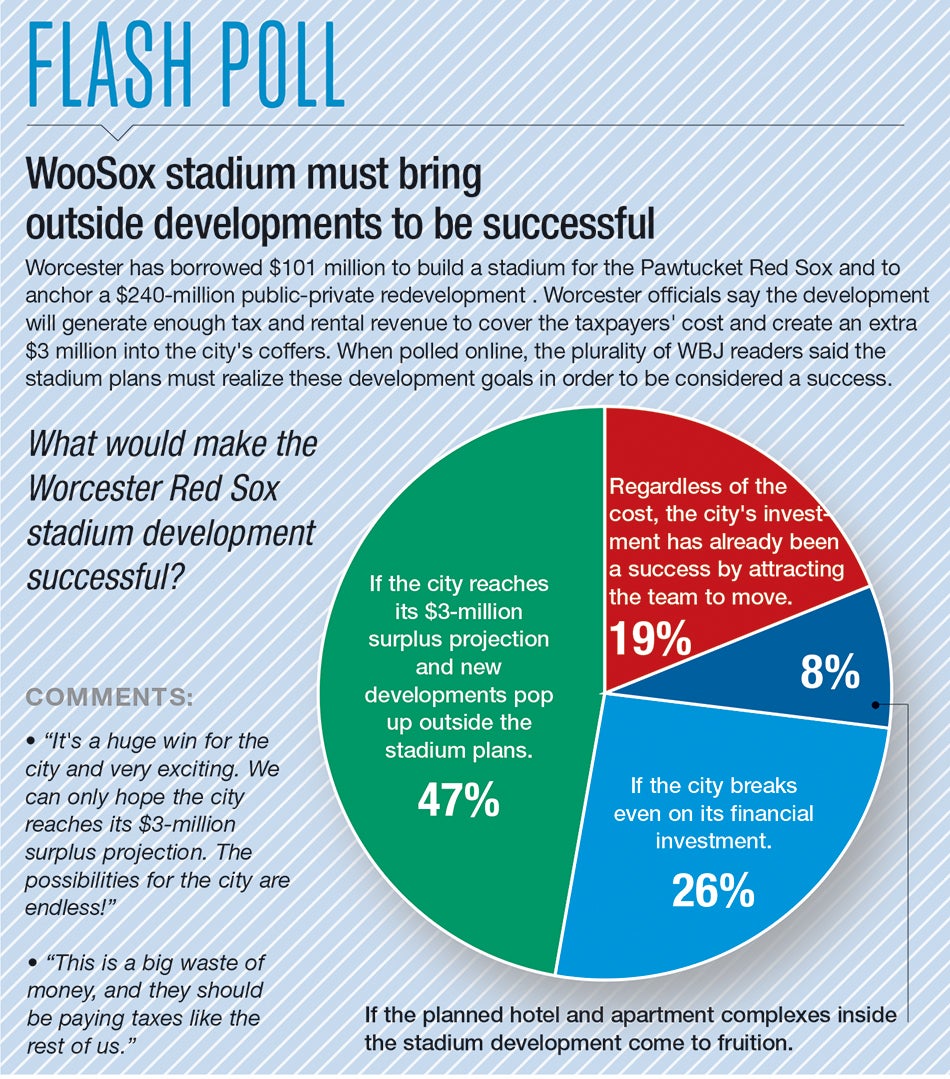
Little has gone right in Hartford since, at least aside from the Yard Goats’ popularity with fans. The park opened a year late, and only after the initial contractor was fired. That contractor, which was supposed to build the $350 million related mixed-use project, then sued the city.
Four years after Hartford agreed to build the park, construction has yet to begin for any of the new development once hoped to help pay for the project, and isn’t close to taking place. In the meantime, the city is covering bond debt payments by dipping into its general fund at $5 million a year. A developer hopes to break ground this year on a smaller $200-million development to be built over six years.
Economic forecasts projecting growth from the ballpark couldn’t stand up to any scrutiny, said Fred Carstensen, an economics professor at the University of Connecticut in Hartford.
“And there was no possible way in which the stadium was going to generate anything like the revenue that was going to pay off the bond issue,” he said.
In a slower-growing region like Hartford’s, any new growth around the ballpark is likely to simply take development from elsewhere in the area – not add to it, Carstensen said. An amenity for residents shouldn’t be mistaken for a driver of new economic activity, he said, even with any related construction.
“It’s not going to be an economic development project in its own right,” he said.
Success stories
Allentown, a former manufacturing city just over an hour northwest of Philadelphia, brought a new team to the area in a similar way to Worcester. In Allentown’s case, it used $17 million in state funds for a new stadium.
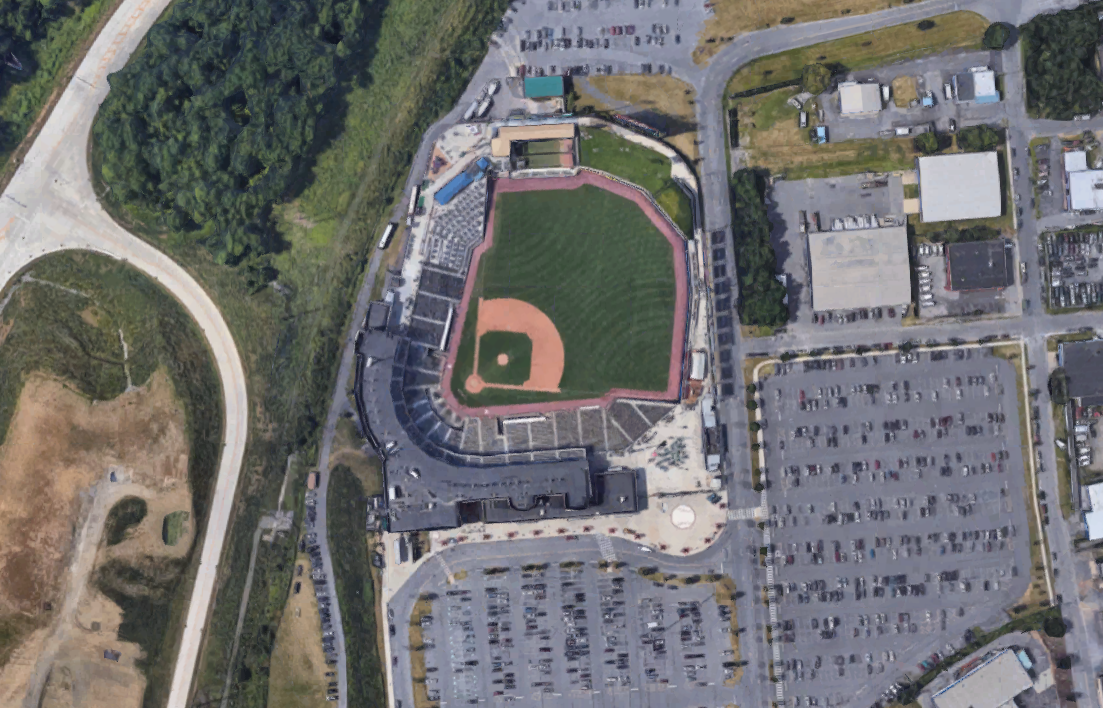
Coca-Cola Park opened in 2008 to host the Lehigh Valley IronPigs, who play in the same league as the Pawtucket Red Sox. Roland Kushner, a business professor at Allentown’s Muhlenberg College, called the stadium a good catalyst for new development in the region, if not necessarily on the park’s doorstep.
“I am a skeptic of public financing of sports facilities,” Kushner said. “However, it worked here.”
Coca-Cola Park was built in a largely industrial area not too accessible from any nearby homes or restaurants. But attracting the team, and the IronPigs’ popularity, Kushner said, brought the region a brand identity and helped bring other new attractions, including a minor league hockey team that moved to new arena in downtown Allentown in 2014.
In the adjacent city of Bethlehem, a casino and hotel complex opened a year after the ballpark and a performing arts center two years after that. Even if planning had already been underway, Kushner attributed both projects in part to Coca-Cola Park.
“There’s a feeling in the community that the success of the IronPigs and Coca-Cola Park made this area a better bet for such large scale entertainment and sports investments,” Kushner said.
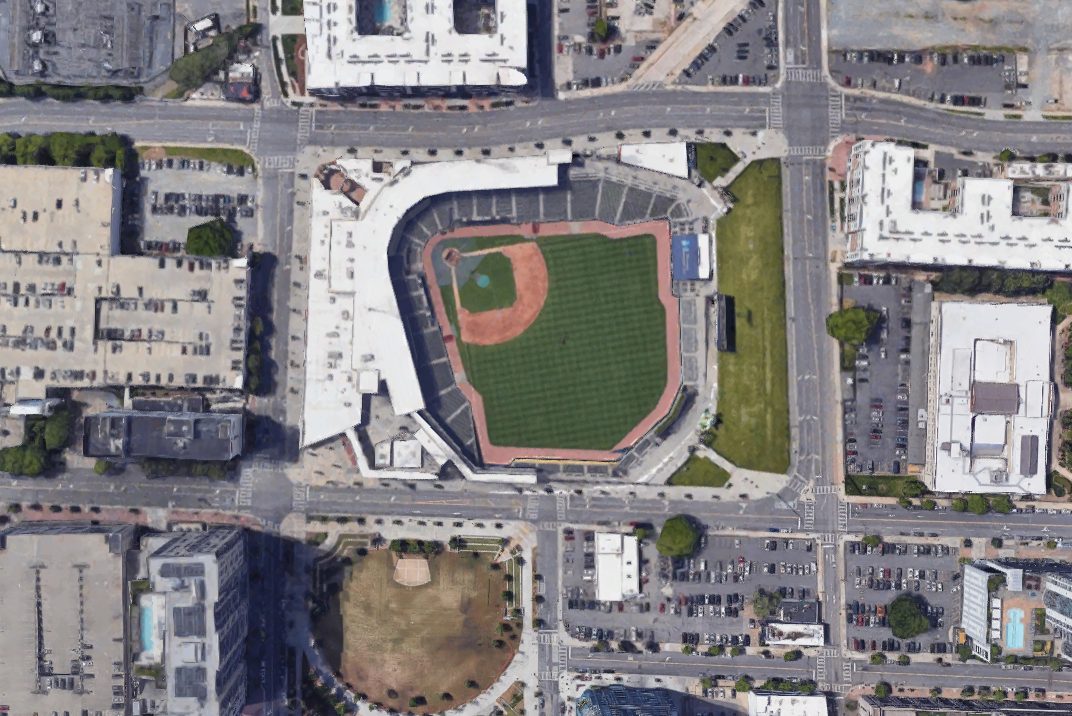
In Charlotte, BB&T Ballpark opened in downtown in 2014, bringing the Charlotte Knights back to the city from a suburb to the south. The city committed $7.25 million in funds from hotel occupancy taxes and $750,000 from municipal service district taxes. Mecklenburg County pitched in $8 million.
A general consensus, Depken said, is much of the growth would have taken place anyway. Charlotte has been a boom city for years, its population growing by 123,000 people from 2010 to 2017.
In one sense, the ballpark has certainly worked: The neighborhood around the park has sprouted new apartments and shops. Gauging the ballpark’s role however is less clear, said Craig Depken, an economics professor at the University of North Carolina Charlotte.
“It’s very difficult to tease out the stadium’s impact compared to the general Charlotte development,” Depken said. “The impacts seem to be rather fleeting, or pretty minimal.”
Cautionary tales
Stockton, Calif., a city an hour east of Oakland, paid for a new stadium opened in 2005 at the edge of Stockton’s downtown on a contaminated site.
The waterfront is improved by the ballpark and an adjacent arena opened the same year, said Jeffrey Michael, the director of the Center for Business and Policy Research at the University of the Pacific in Stockton.
But there’s no evidence, he said, the facilities have brought people to live in the neighborhood or spend more money there. The park is surrounded by a few parking lots and industrial parcels.
“In fact,” Michael said, “I don’t think there is a single restaurant within several blocks.”
Worse, the ballpark was cited as one reason for Stockton’s 2012 bankruptcy filing, one of the largest municipal bankruptcies in the country.
“If you walked around the area, it would look very much the same as it did in 2006,” said Pete Schroeder, a professor at University of the Pacific who teaches about sports sociology, management and marketing.
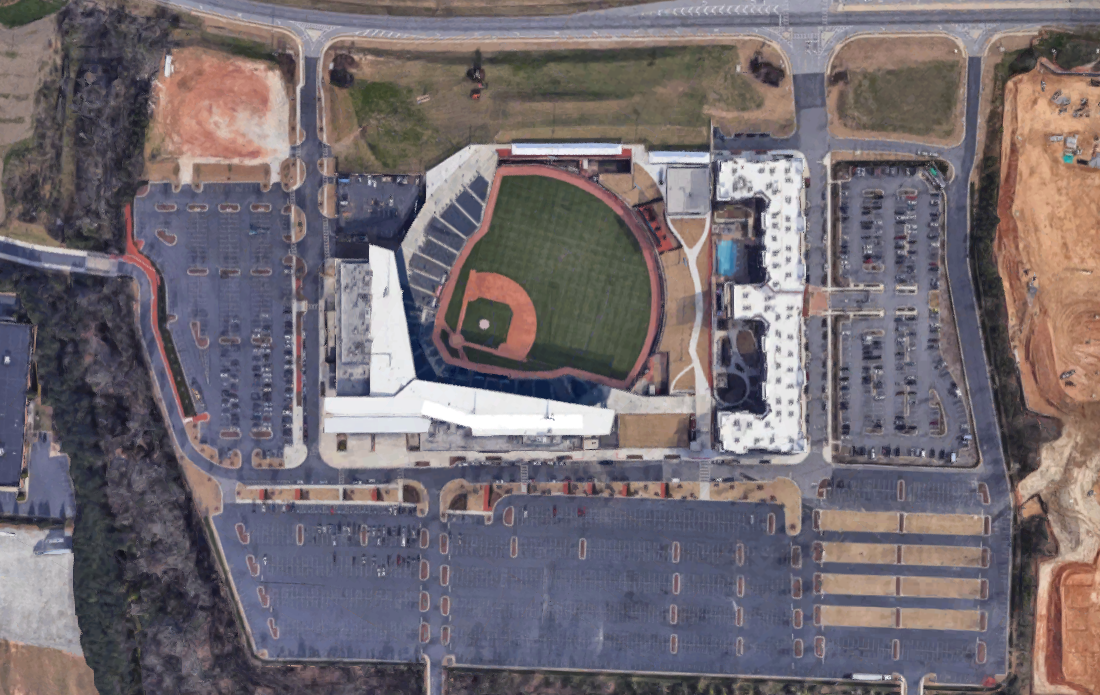
Another booming area, Gwinnett County in Georgia, had ambitious plans for a wooded swath of land when it signed a deal in 2008 to bring the Atlanta Braves’ top farm team from Virginia.
A developer planned 300 hotel rooms, 610 residences, along with retail and offices surrounding the stadium, according to the Atlanta Journal-Constitution.
“It was built with a Field of Dreams mentality,” said J.C. Bradbury, an economics professor at nearby Kennesaw State University, alluding to the baseball movie’s famous line: “If you build it, they will come.”
“The reality,” Bradbury said, “is that people don’t move to be close to a ballpark.”
Only some of those apartments have been built, and none of the rest of what was envisioned.
“It has gone about exactly as every economist has predicted it would go,” Bradbury said. “I hope the experience Gwinnett has had isn’t repeated in Worcester.”
CORRECTION: Pete Schroeder’s description has been updated to reflect his expertise. He is not an economics professor.
